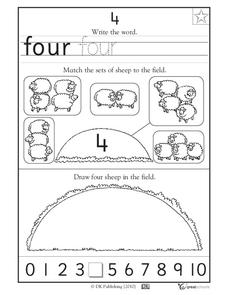DK Publishing
Learning 11 and 12 - Write the Numbers
Make number concepts fun with this party-themed set of activities aimed at familiarizing young counters with 11 and 12. They begin by tracing each numeral before printing it once on their own. Next, learners count a set of balloons and...
DK Publishing
Learning 15 and 16 - Write the Numbers
Focus on the numbers 15 and 16 with young counters as they explore number value and printing. First, they trace each number before printing it on their own. Next, scholars examine sets of objects and circle the corresponding number from...
DK Publishing
Learning 9 - Write the Number
As novice counters learn numbers 0-10, use this exercise to focus on the number nine. They begin by tracing and printing the numeral several times. Next, learners count sets of stars and record the totals, all of which are nine....
DK Publishing
It's Raining Numbers! - Mixed Tables
It's raining math problems! Use this multiplication and division skills practice on a rainy day as scholars fill in water drops to complete number sentences. They fill in products, factors, dividends, divisors, and quotients to solve...
DK Publishing
Learning 6 - Write the Word
Which plate has six cookies? Focus on the number six with novice counters as they solidify single-digit number concepts. Keep in mind pre-readers may have trouble with this, as there are written instructions they will need to understand....
Texas Instruments
Finding Linear Models Part III
Explore linear functions! In this Algebra I lesson, mathematicians graph data in a scatter plot and use a graphing calculator to find a linear regression and/or a median-median line. They use the model to make predictions.
DK Publishing
Learning 4 - Write the Word
Focus on the number four as youngsters complete several exercises to solidify this number concept. Note pre-readers will have a hard time with this, as it requires reading instructions. Consider doing together as a class or having...
Curated OER
Learning 3 - Write the Number
Do this for numbers 1-10, but in this one youngsters just focus on the number three. First, they trace the digit three times (of course!) and try a few on their own. Next, scholars count how many bears, bowls, and beds there are, writing...
DK Publishing
How Many Are Left?
To help novice mathematicians understand subtraction concepts, offer them visual representations of the operation. Here, they look at sets of circles. For each of the 16 sets there is a given number they are to cross out, writing how...
DK Publishing
Draw the Shape ~ Counting Circles
In order to count circles, youngsters have to know what they look like! First, they examine a circle, trace two by following the arrow, and draw a couple on their own. Now that they are familiar with this shape, they count and record the...
DK Publishing
Finding Multiples 2, 5, and 10
Solidify multiplication facts by identifying multiples of two, five, and 10. There are six sets of numbers here, and for each set learners circle those that are multiples of one of these numbers (two sets for each). Use the example to...
DK Publishing
Addition: Count and Color, part 3
Approach addition with sets of objects to show scholars the operation visually. There are four sets of images here arranged as addends in an addition number sentence. Learners count them and color in the total in a final set. All answers...
DK Publishing
Draw the Shape ~ Counting Rectangles
It's all about rectangles here, and young geometers begin by following a dotted outline to trace the shape, then print one of their own. Next, they examine three pictures to count the rectangles in each. Learners practice writing...
DK Publishing
Counting Bugs! - Numbers and Pictures
Youngsters become familiar with single-digit numbers as they count bugs and represent the value in three forms. For each, scholars write the number in both numerical and word form and also fill in dots on a domino. After completing...
Utah Education Network (UEN)
Solving Single-Variable Equations Part II
Brainiacs explore the concept of solving single-variable equations.They use inverse operations to solve equations, and participate in activities such as balancing an equation scale. This is an awesome lesson plan, complete with game...
Everyday Mathematics
Mathematics Within: Slope and Triangles
Learners discover a method for determining the slope of a line by creating and comparing similar triangles. They fold coordinate grids to make three similar triangles then measure the sides to compare the relationships between the...

















